The Anti-Asian Racism During the COVID-19 Pandemic Has Everything to Do with Black Lives Matter
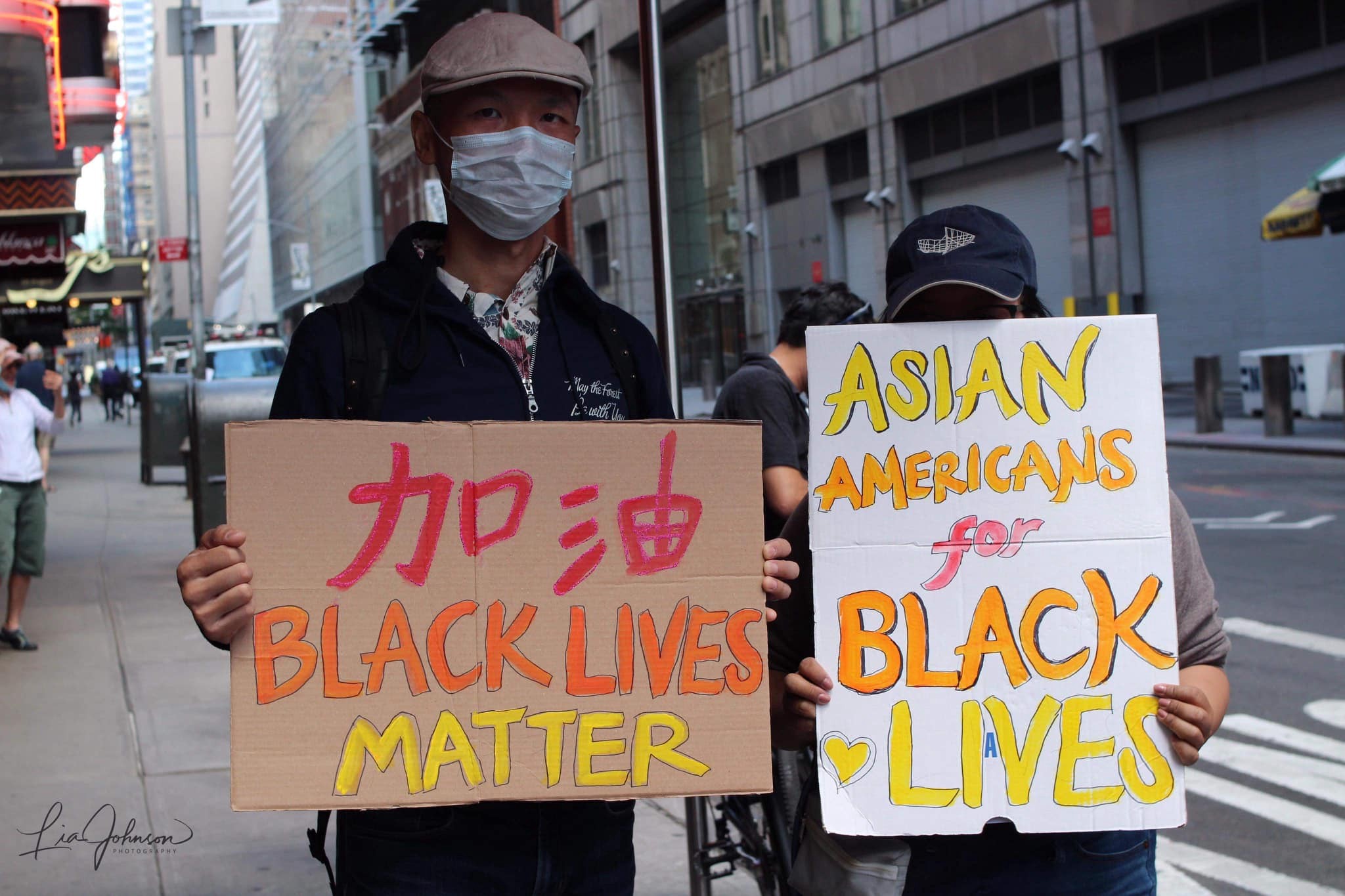
Authored by Beverly Cotter and Mary Yu Danico
The COVID-19 pandemic is revealing what we can do to fight the systemic injustices that have existed against people of color (POC).
As front-line workers battle the deadly virus, there has been a spike in anti-Asian hate crimes. Scholars documenting the rise have seen openly hostile attacks on Asian Americans living in San Francisco, New York, Los Angeles and other cities. The yellow peril¹ and scapegoating of Asian Americans are not new. The documentary Asian Americans on PBS² highlights the long history of racism and violence against Asian Americans. Hence, while the xenophobic anti-Asian sentiments are alarming and troubling, they are not surprising. To say that there has been a significant spike in anti-Asian sentiments does not truly address the complexities of the situation. For millennials who grew up during the Clinton, Bush, and Obama eras, and members of Gen Z whose presidents have been Barack Obama and Donald Trump, the idea of using Asian Americans as scapegoats may not completely resonate. It does not help that most people living in the U.S. are uncomfortable discussing politics openly as it can make or break friendships, relationships, and even families. This became abundantly clear when Donald Trump was elected in 2016. We have had racist presidents before from the signing of the 1882 Chinese Exclusion Act³, Executive Order 9066⁴ and immigration laws that have discriminated against non-European or low-income earning peoples. Yet, we have never had a president who has so overtly spread such racist ideas to so many. From tweeting racist ideologies during the span of his presidency to unapologetically calling this virus the “Chinese Virus”, Trump has publicly fanned the flames of the racist narratives by retweeting and supporting false claims of right wing conspirators.
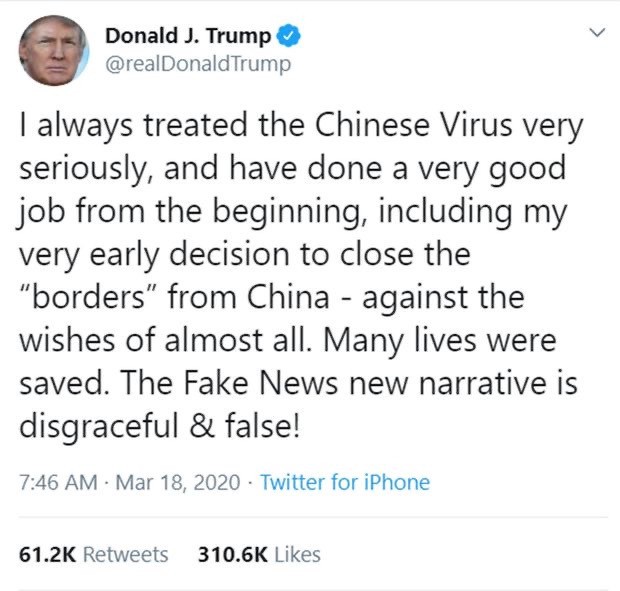
“It’s not racist at all,” Trump said, explaining his reasoning after a reporter told him many consider it racist. “It comes from China, that’s why.”
Trump’s tweets or press conferences during the COVID-19 pandemic are not the sole reason for the rise in anti-Asian sentiments. Rather, they are a result of the failure of the U.S. as a nation to acknowledge the institutional racism that exists because of this country’s hatred and fear of indigenous and Black peoples. Dr. Dylan Rodriguez states, “this country was founded on anti-Blackness, anti-indigeneity, and colonization. This allows xenophobia to persist”⁵. The failure of all people living in the U.S. to wake up to the racialized spaces and places in the nation will only continue to ignite hate and racism-colorist ideologies as Western cultures stem from genocide, where Black and darker-skinned people are dehumanized.
On May 25th, the fear, anger, and frustration over a system that continues to devalue life erupted. George Floyd was killed by Minneapolis police. Four police officers took Floyd down because a store owner claimed that he gave a fake $20 bill. Twenty dollars. Twenty dollars was the reason for four police to violently push Floyd to the ground and hold him there with a knee for 9 minutes. For 9 minutes Floyd begged for life and expressed “I can’t breathe.” Breath. The air that we breathe that so many of us now understand how fragile it is. COVID has woken us up to the virus that could get us. Yet, for Black Americans the virus has always been here waiting to take their last breath. Racism is the virus that has flourished in America and during a pandemic, the police officers decided that Floyd’s life was worth a mere $20. As U.S. Representative Hakeem Jeffries stated, “racism is a cancer that poisons our society”.⁶
“In 1903, sociologist W.E.B. DuBois observed that ‘the problem of the twentieth century is the problem of the color line.’ In 2020, what DuBois described as ‘the relation of the darker to the lighter races of men in Asia and Africa, in America and the islands of the sea’ remains a terrible conundrum, particularly in the United States. Though the U.S. was founded on and continues to espouse principles of equality, the historical roots of the present social, economic, and political inequality, have laid the foundation for on-going state sanctioned and supported violence against Black, indigenous, Latinx, Asian American, immigrant, and LGBTQ communities. The recent killings of George Floyd, Breonna Taylor, Ahmaud Arbery, and Tony McDade highlight this persistence and its devastating impact.”⁷
A Reawakening
So much has changed since our survey⁸ data was collected in March and April (refer to end of article and endnote for more information on the survey). Our country is trying to understand the “new normal”, but we have awoken to the reality of the old normal on May 25th. The old normal is anti-Black violence. The old normal is dismissing police violence as the result of “one bad apple.” The old normal is punishing the bad apples to mollify and distract us. The old normal is to put communities of color against each other. Yet, something incredible has happened. Floyd’s death symbolizes the lives of so many Black lives. People around the globe have decided to stand in solidarity with Black Lives Matter; an awareness that silence meant complacency and that when united, the people had the power to do something. How is this moment different? The understandable fear of COVID-19 has led many countries to shut down with a stay at home order. The luxury of living in this century is that while we have to practice physical distancing, we are able to stay socially connected via social media and other media sources. In a very strange turn of events, the world is connected because of COVID-19. When communities protested Floyd’s death on May 26th, the hostile militarized response from the police state⁹ toward Americans who exercised their rights created a global wave of dissent from people who had enough. We witnessed the attack on free press, on the elderly and the youth, and we realize that while this moment has made it horrific to experience and watch, for Black lives this has been their constant reality. Now in June, with the recent murders of George Floyd, Ahmaud Arbery, and Breonna Taylor (only to name a few) by police brutality, we are experiencing a surge of support for the Black Lives Matter movement. We have found it inconceivable to deny the attention that this movement deserves, as well as the development of the field on how communities can work together to combat the systemic racism and injustices that have gone un-treated for far too long. There is no ‘one size fits all’ with this narrative, yet one major truth is that racism has everything to do with Black Lives Matter.
Members of the Asian American community have experienced, witnessed, and suffered from racism that has been integral to U.S. race relations. Predictably, our study⁸ shows that Asian Americans are more worried about anti-Asian violence due to the Coronavirus than actually contracting the virus itself.
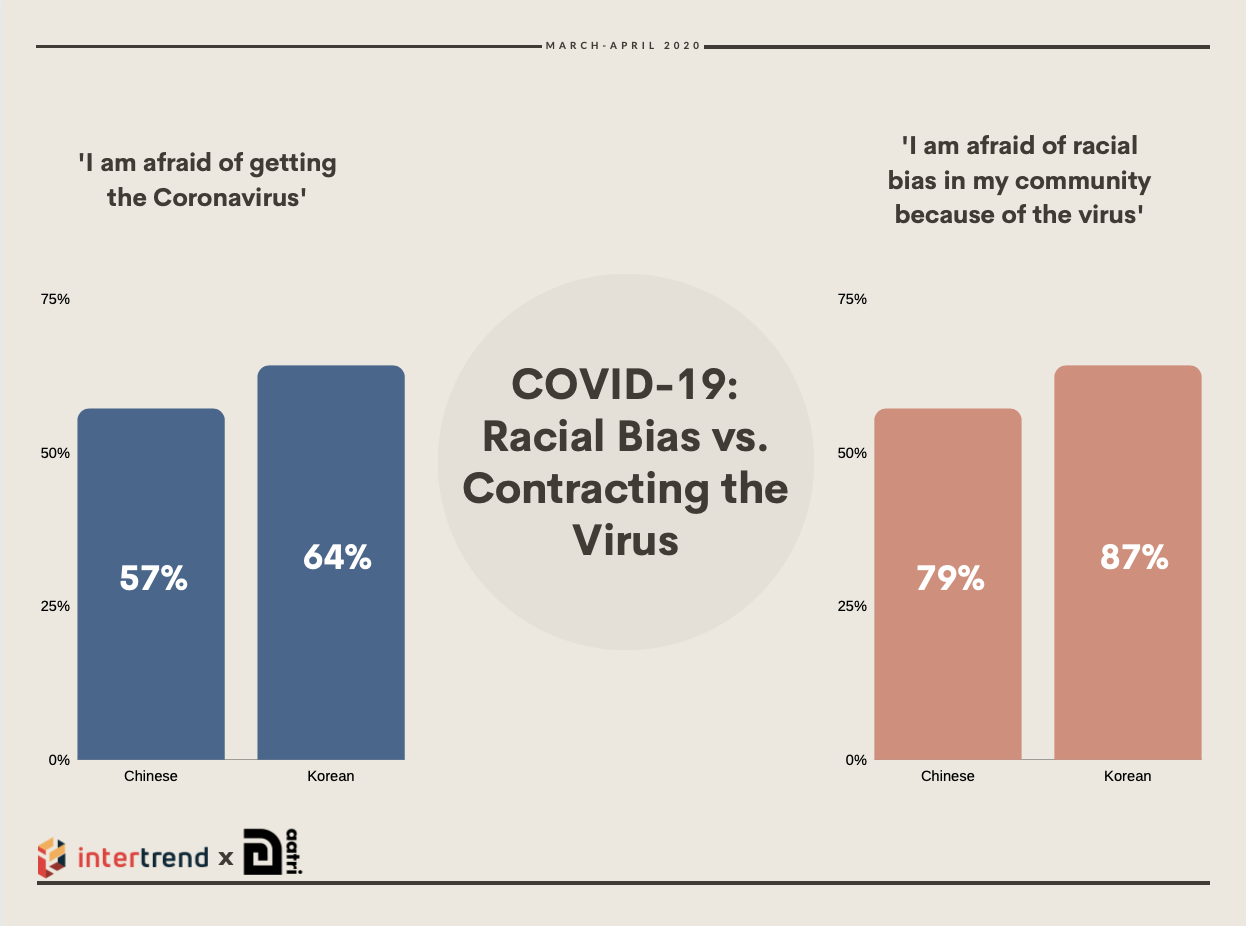
“Asian Americans are more worried about anti-Asian violence due to the Coronavirus than actually contracting the virus itself.”
On June 4th, the Public Health Center stated that racism was more of a threat to lives than COVID-19, underscoring the reality of systemic racism and its attack on marginalized communities.¹⁰ Dr. Ali Mokdad from University of Washington’s Health Metrics Department seemed to agree with the assertion and was more direct when he stated, “We have had over 107,000 deaths from COVID-19, but in my opinion, racism is more dangerous to my country [United States] than COVID-19.¹¹ Racism is a public health issue and Asian Americans are juggling these multiple viruses at once. The big difference between the two viruses is: COVID is not human generated, racism is.
Organizations such as ‘STOP AAPI HATE’ have documented the increase in hate crimes against AAPI communities since March 19 (around the same time the peak of tensions and fear from the virus hit the U.S.) Reports include accusations that the virus is ‘their fault’ and that they should ‘go back to China’. The Asian Pacific Policy & Planning Council have collected over 1700 reports from 45 states since March.¹² Cynthia Choi, co-executive director of Chinese for Affirmative Action said, “We want community members to know that they are not alone; they can speak out and help stop the spread of bigotry”.¹³ And, in March alone, nearly 100 hate incidents were documented in Los Angeles County, which were not limited to verbal assaults (7% were physical). As hate crimes continue to increase, the AAPI community is showing more fear to the racial bias associated with the virus. It is clear that the ideologies that the U.S. was founded upon years ago remain intact today in 2020.
What is different today is that social media has offered community organizations and researchers the opportunity to reach out and collect information more quickly than ever. Social media has created virtual spaces for folks to convene, share, mobilize, and even amplify the injustices that are more often than not have gone unnoticed.
Seizing Control of Media for Change
The global pandemic has led to increased engagement and viewing of information on social media and the media has played a crucial role in this evolution. Initially, people logged on to see what was happening with COVID-19 as it spread with no vaccine in sight. Orders to stay at home and/or quarantine became the “new normal” and people looked for continued ways to stay connected. From January to April, most people were overwhelmed with news of death, loss, and infections from COVID-19. For those in our study, they expressed concern for the virus but expressed a need to get more information about how to cure it. We then began to see an increase in the media portrayal of racial incidents. The viral video of George Floyd witnessed by the world became a call for resistance as dismantling of the police state.
Korea, a country known for their social media presence, is rallying behind the Black Lives Matter movement, protesting the murder of George Floyd and others. The Korea Times and The Korea Bizwire are among the many sites that have highlighted the Korean community’s efforts.¹⁴ ¹⁵ Our own survey shows that among the Asian Americans surveyed, Koreans are more connected to media and in particular consume in- language media sources more than their other Asian counterparts.⁸ They seek out information and are quick to seek out answers in both Korean and in English. Protesting is a valued action in Korea and while there is racism and injustices there, the younger generation is globally connected and much more woke to how Black Lives Matter impacts race relations for all ethnic minorities.

The support for Black Lives Matter is nuanced, fresh, and, more importantly, it appears to be working. Social media accounts once limited to ‘selfies’ or sharing lifestyle content have quickly shifted to the sharing of resources (e.g. safe ways to protest), videos depicting the severity of police brutality, posts holding others accountable for their wrongdoings, and more. The creation of hashtags of #blackouttuesday or #blacklivesmatter, to K-pop fans resisting the ‘#allivesmatter’ or ‘#whitelivesmatter’ hashtags. Social media opens up the discussions that need to happen, and we have seen endless posts of support, motivation, and the sharing of ideas with one another. Although COVID-19 is not something to be celebrated, it may have given people the opportunity to become more aware of the injustices that exist in our system.
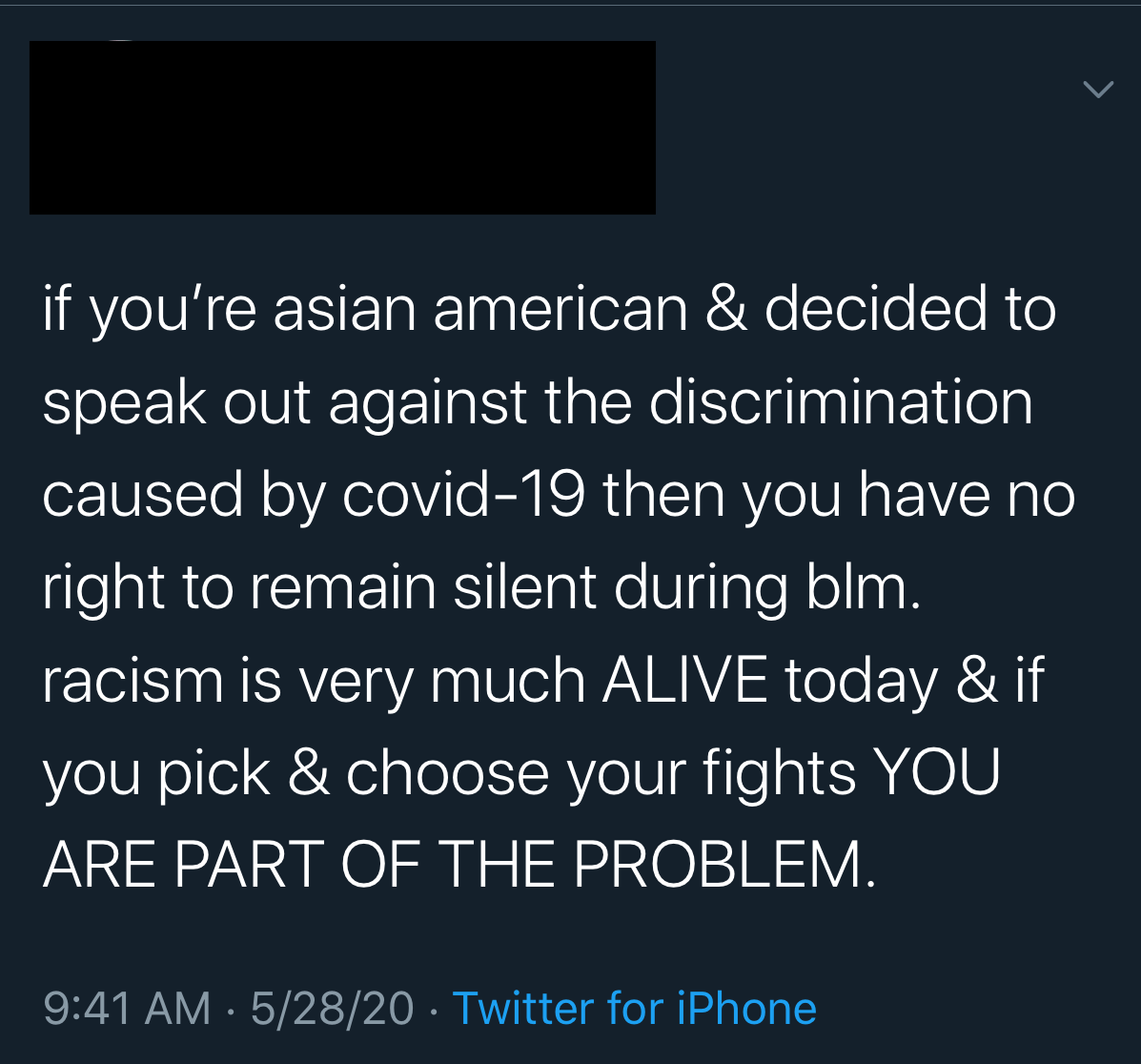
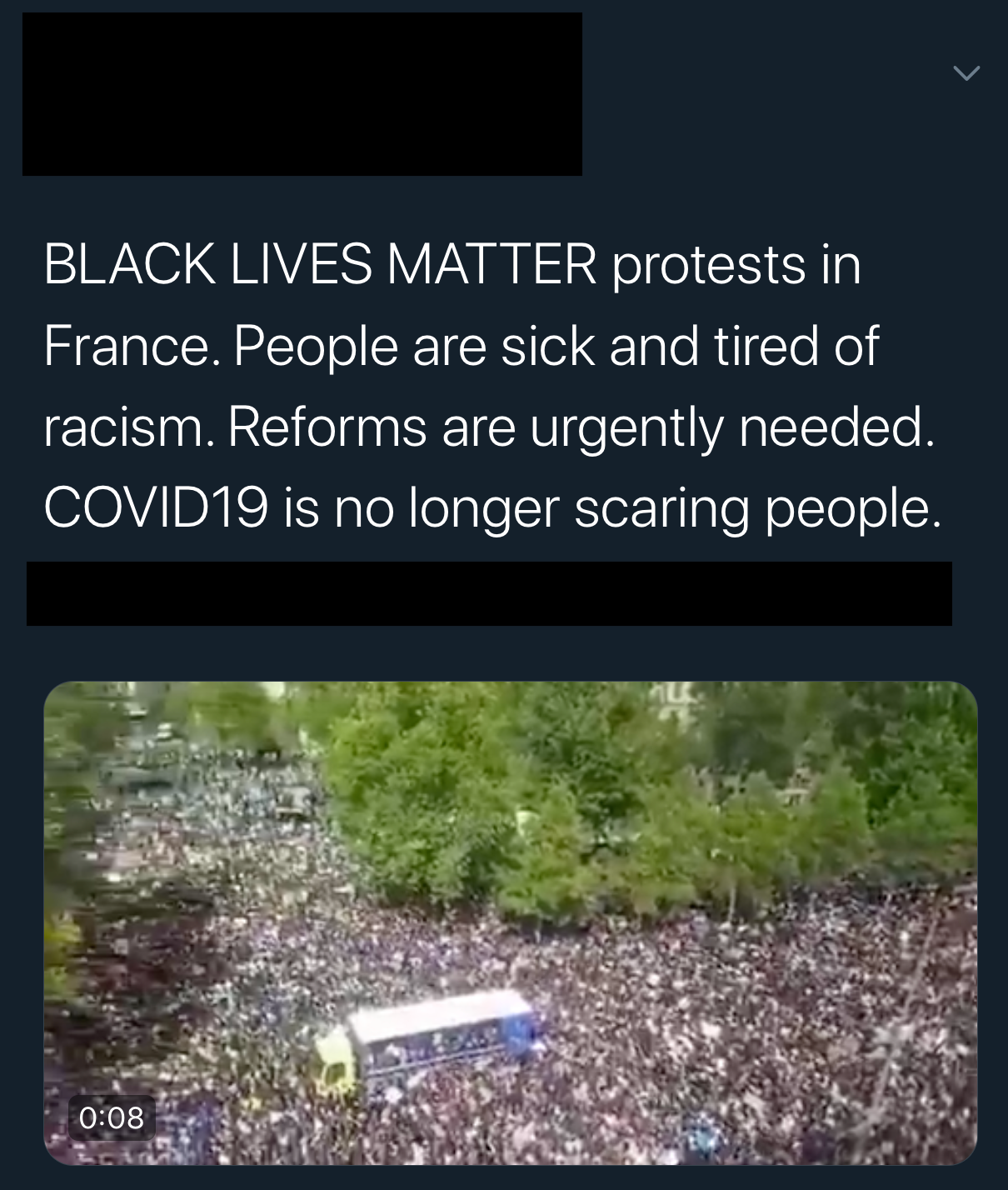
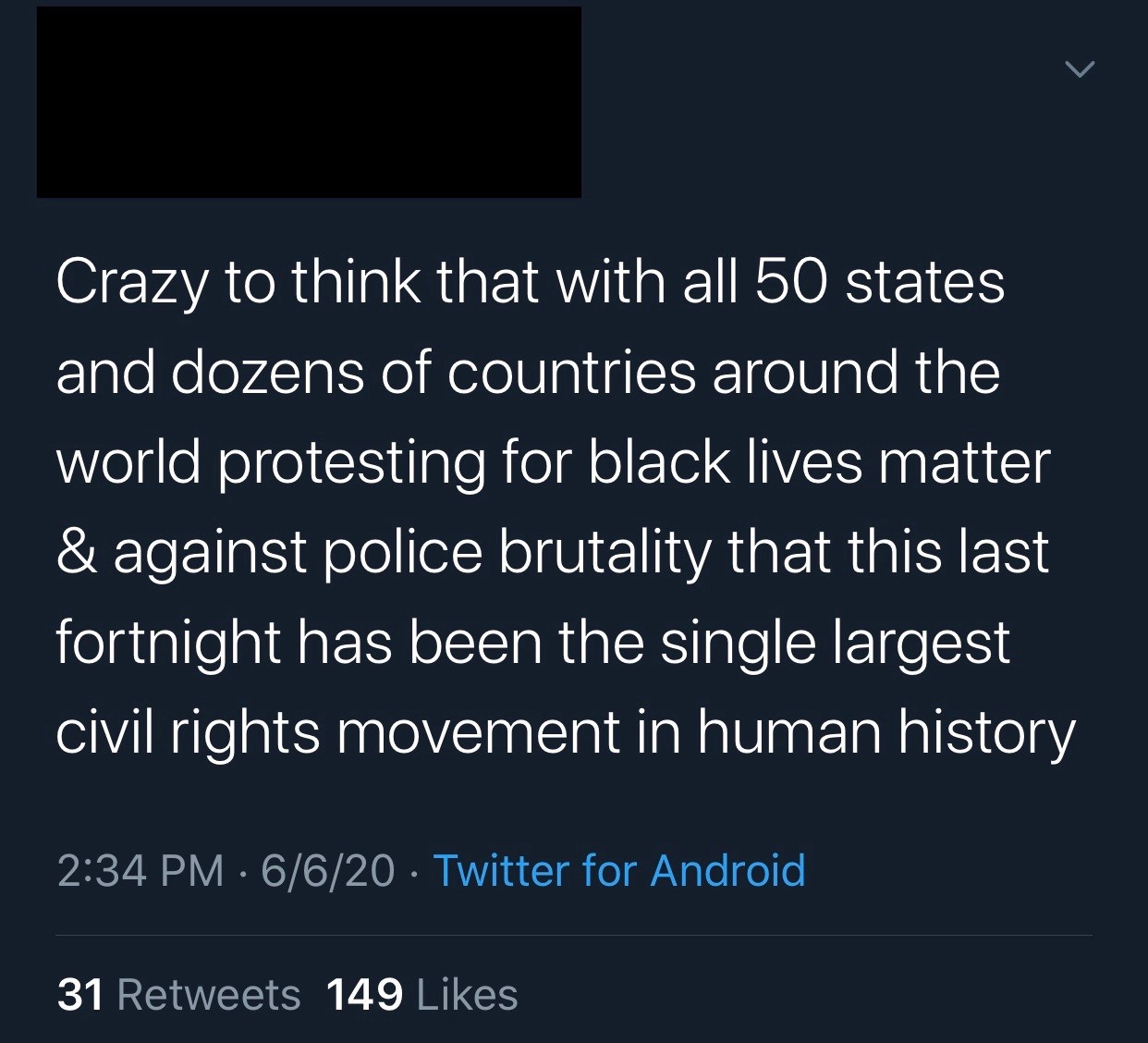
Now, we see France, Germany, Japan, New Zealand, and Taiwan (among others) joining this global revolution against anti-Blackness. The same countries that have been active on social media during the pandemic appear to also be turning their pent up frustrations into activism. The realities of the disparities that exist in our system may have become more apparent as people have stayed plugged into their devices, and slowing down from the business of their day-to-day lives. They may be more informed, more aware of the injustices and uproars happening. To them, social justice may matter more than social distancing because racism is a battle they feel is worth fighting for.
What Can Asian Americans Do?
The resistance seems to be working, but the movement is far from over. Asian Americans are attempting to mobilize to inform their own communities while working in partnership with Black Lives Matter. The COVID-19 and anti-Black protests have fueled a global protest against the system, but it has also marked Asian Americans as targets of violence. In Minneapolis, a south Asian owned restaurant was burnt, but the owner made it clear that they could rebuild and it was important to find justice for Floyd. On June 1st, during the riots in Richmond, the Shen and Chang family’s jewelry store was robbed and family members inside were beaten and attacked. Yet, on their GoFundMe page, a family member wrote, “Black lives matter. Black communities matter. This movement matters. These protests matter. We need to bring justice to the lives lost and healing to the communities”.¹⁶ Seoul Taco, a Mexican Korean restaurant experienced damages as well, but David Choi (the restaurant owner), wrote on Facebook: “Everything in my store will be replaceable, while lives are being senselessly lost on a way too regular basis, is the way bigger issue”.¹⁷ Despite their own struggles and pain, they are still unapologetically showing support for the Black Lives Matter movement. We have also seen protestors carrying signs that say: “Yellow Peril Supports Black Power”, while Gen Z Asian Americans have been using social media as a way to call for change and more support from their communities.¹⁸ The support and continued solidarity of Asian American communities is needed more so than ever. As we have seen an uprising in hate towards these communities during the COVID pandemic, we have also seen that this has really shaped the way that members of the Asian American community (along with the help of social media & other communities), have been key members of this revolution.
We are at a critical juncture in our history. The injustices toward Black lives continue to trickle down to other ethnic groups and we are slowly seeing communities waking up to see how connected anti-Blackness is to injustices everywhere. This is a difficult time for Asian Americans as we see a disproportionate number of Filipino health workers impacted from COVID and we have also seen spikes in anti-Asian hate crimes from all groups. The hurt, anger, and fear from Asian American communities are valid and real. One may think that this would increase interracial conflict and would put communities of color at war with each other, but the transmission of information and knowledge via social media has allowed people to recognize how we are all in this fight together.
Asian Americans who have been at the forefront of racist tweets and attacks acknowledge that supporting BLM and fighting systemic racism is a start, however, not all Asian Americans feel this way. The political machine continues to flame the stereotypes of Black lives and Asian American model minorities to highlight the differences to ensure a coalition will not happen. Yet, we have seen that the grassroots movement is working and Asian Americans and other groups are forging alliances to fight structural racism. We are witnessing the revival of a mass movement for racial equality by supporting Black lives. The question is, which side of history do you want to be remembered for?
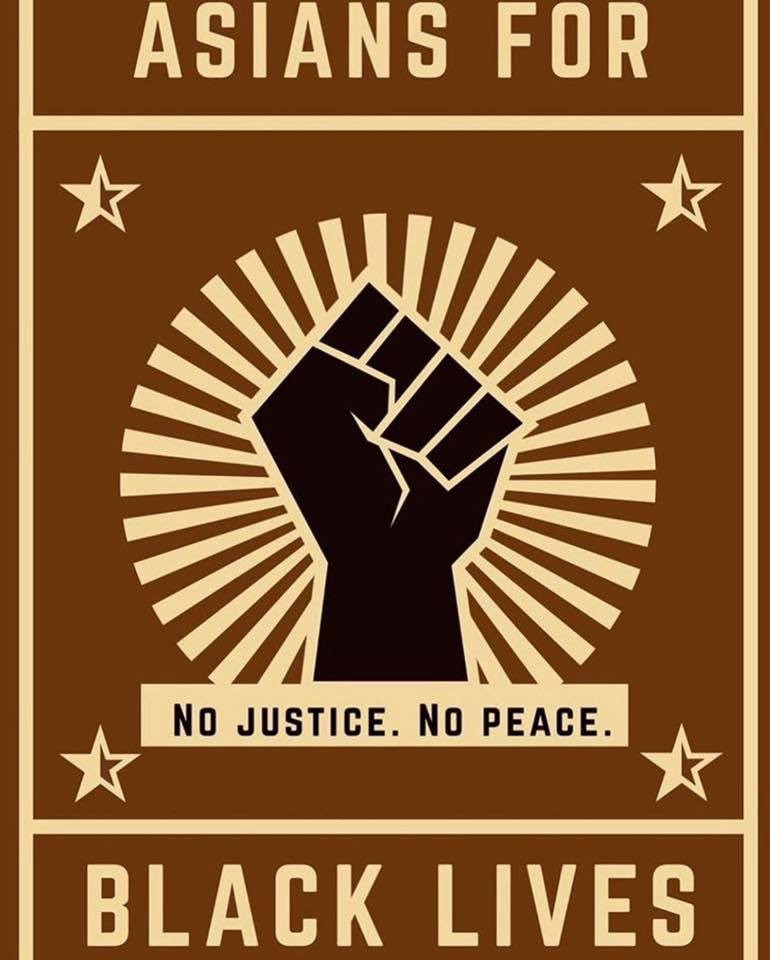
---
About the Study
In collaboration with InterTrend Communications, the Asian American Transnational Research Initiative at Cal Poly Pomona conducted a 71-question, quantitative survey to assess how Asian Americans were getting their information about COVID-19 and how they felt about the racism against Asian Americans during the critical periods of the pandemic (March 14 to April 27)8 Coming from ‘hotspots’ of the pandemic (Southern California, New York, Chicago, and Dallas), the survey grasped an exclusive look into the toll the pandemic has taken on these communities.
The response was swift with 609 members of the Asian American community who self-identified as Chinese, Korean, and other Asian American populations had filled out the survey, but overall, the sample largely consisted of Chinese and Koreans. Coming from ‘hotspots’ of the pandemic (Southern California, New York, Chicago, and Dallas), the survey grasped an exclusive look into the toll the pandemic has taken on these communities. For a detailed summary of the results, please contact info@intertrend.com.
About the Authors
Mary Yu Danico is the Director of the Weglyn Endowed Chair for Multicultural Studies, Director of Asian American Transnational Research Initiative, and Professor in Sociology at Cal Poly Pomona. She is the author of The 1.5 Generation: Becoming Korean American in Hawaii (UH Press), Asian American Society (Greenwood Press), Transforming the Ivory Tower: Challenging Racism, Sexism, and Homophobia in Higher Education (UH Press), and editor of Asian American Society (SAGE PRESS), book chapters and numerous articles. She is an executive coach and creator and developer of peer mentor programs at Cal Poly Pomona.
Beverly Cotter is an incoming first-year Psychology Ph.D. student at UC Davis and Cal Poly Pomona ’20 alumna. She has been a research assistant for the Asian American Transnational Research Initiative since 2018. Her areas of expertise include topics within the field of psycholinguistics and bilingualism, more specifically what drives language processing in real time and further unpacking whether there are differences in the methods by which people process language.
References
¹ “Yellow Peril” is a term that was initially introduced in the late 19th century. It refers to the fear held in Western societies, specifically in the U.S., in which Asians (particularly the Chinese at the time) would threaten the democracy and values that the U.S. This is a form of discrimination towards Asian American communities.
² Asian Americans. A production of WETA Washington, DC and the Center for Asian American Media (CAAM) for PBS, in association with the Independent Television Service (ITVS), Flash Cuts and Tajima-Peña Productions. The series executive producers are Jeff Bieber for WETA; Stephen Gong and Donald Young for CAAM; Sally Jo Fifer for ITVS; and Jean Tsien. The series producer is Renee Tajima-Peña. Arlington: PBS, 2020.
³ The Chinese Exclusion Act of 1882 was the first immigration law that was responsible for excluding an entire ethnic population. It prevented Chinese laborers from coming to the U.S. and prevented Chinese nationals from obtaining U.S. citizenship.
⁴ Executive Order 9066 was a policy signed into place in 1942 by President FDR that interred all people of Japanese descent into concentration camps between 1942 and 1945.
⁵ Eddie Conway, “Professor Dylan Rodriguez talks with Eddie Conway about Anti-Chinese Racism + Xenophobia” AAPI Women Lead, 2020, https://www.imreadymovement.org/post/professor-dylan-rodriguez-talks-with-the-eddie-conway-about-anti-chinese-racism-xenophobia
⁶ Brandi Buchman, “Democrats Push Sweeping Police-Reform Legislation,” Courthouse News Service, June 08, 2020. https://www.courthousenews.com/democrats-push-sweeping-police-reform-legislation/
⁷ The Sociology Department at Cal Poly Pomona published a statement against anti-Black violence on June 04, 2020. The statement was published online, posted on social media platforms, and sent to students.
⁸ In partnership with Intertrend Communications, the Asian American Transnational Research Initiative created a 71-question quantitative survey to assess how Asian Americans were getting their information about COVID-19 and how they felt about the racism against Asian Americans during the critical periods of the pandemic (March 14 to April 27) Coming from ‘hotspots’ of the pandemic (Southern California, New York, Chicago, and Dallas), the survey grasped an exclusive look into the toll the pandemic has taken on these communities.
⁹ Police state refers to a type of government that exercises their power through a police force. Freedoms of the people are suppressed in this type of governmental system.
¹⁰ Dan Diamond, “Suddenly, Public Health Officials Say Social Justice Matters More Than Social Distance,” Politico, June 4, 2020, https://www.politico.com/news/magazine/2020/06/04/public-health-protests-301534?fbclid=IwAR3RQV_6RAercI52XCNtOGT5rZMYXYdn2tTM3RDCb2877yABa2YmRKtmdYk
¹¹ King 5. “UW doctor says racism is more dangerous to America than COVID-19,” YouTube video, 02:33. June 04, 2020. https://www.youtube.com/watch?v=t0Th5aUysMU
¹² Asian Pacific Policy & Planning Council, “Stop AAPI Hate,” Asian Pacific Policy & Planning Council, June 06, 2020, https://www.asianpacificpolicyandplanningcouncil.org/stop-aapi-hate/
¹³ Chinese for Affirmative Action, “Website documents anti-Asian discrimination amid coronavirus crisis (The Hill),” Chinese for Affirmative Action, March 23, 2020, https://caasf.org/in-the-news/page/4/
¹⁴ The Korea Times, “Activists rally in Seoul to support Black Lives Matter movement,” The Korea Times, June 06, 2020, https://www.koreatimes.co.kr/www/nation/2020/06/177_290790.html
¹⁵ The Korea Bizwire, “Korean Americans Join Black Lives Matter Protest,” The Korea Bizwire, June 08, 2020, http://koreabizwire.com/korean-americans-join-black-lives-matter-protest/161740
¹⁶ Asian Dawn, “Asian Family Dragged, Beaten, Leg Broken & Robbed of Everything On Them,” Asian Dawn, June 08, 2020,
https://www.asian-dawn.com/2020/06/08/asian-family-dragged-beaten-leg-broken-robbed-of-everything-on-them/
¹⁷ Claire Wang, “Damaged Asian businesses show solidarity with Black Lives Matter protesters,”
NBC News, June 04, 2020, https://www.nbcnews.com/news/asian-america/damaged-asian-businesses-show-solidarity-black-lives-matter-protesters-n1224766
¹⁸ Sara Li, “Asian American Women Must Stand with the Black Lives Matter Movement”, InStyle, June 10, 2020, https://www.instyle.com/news/asian-american-women-need-to-stand-with-blm